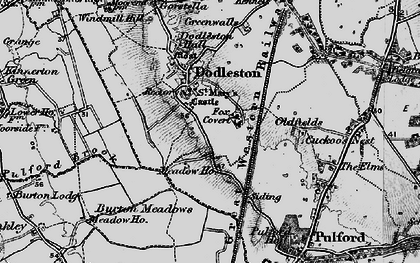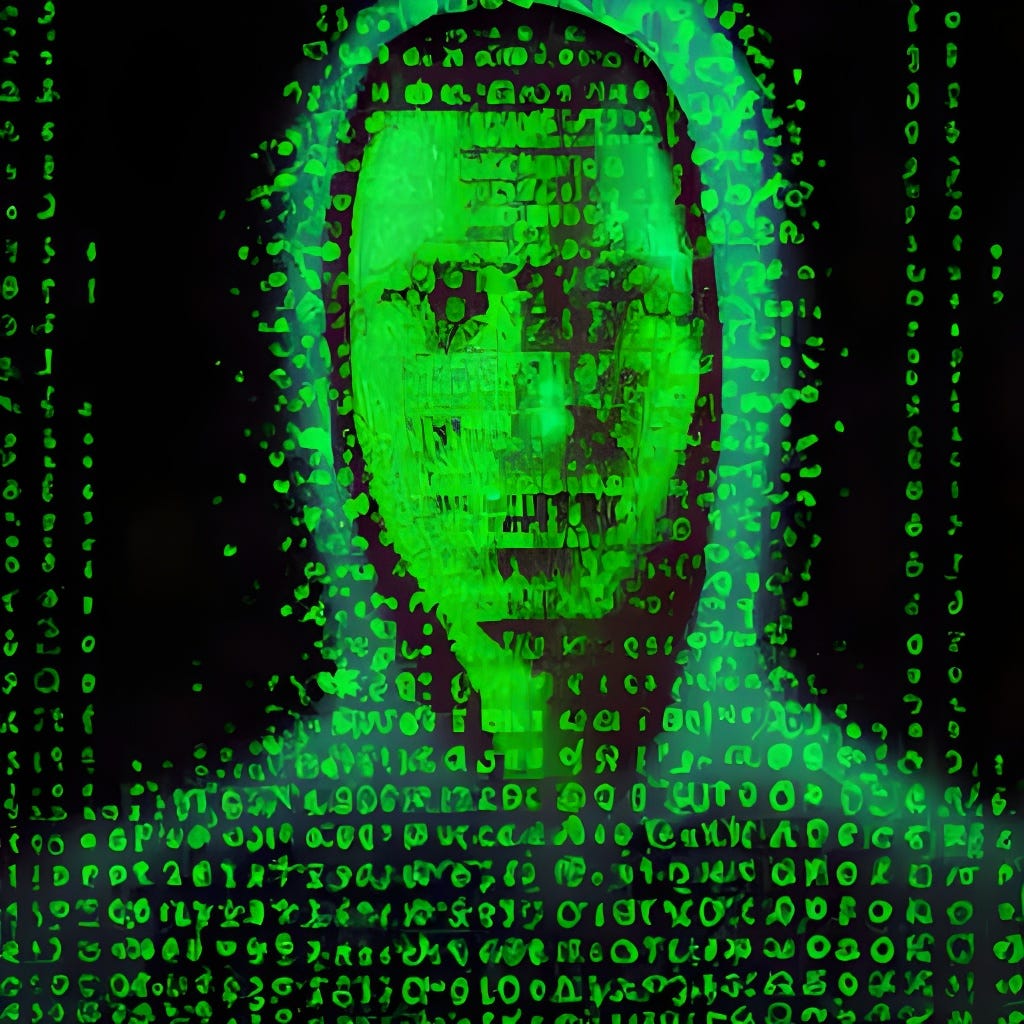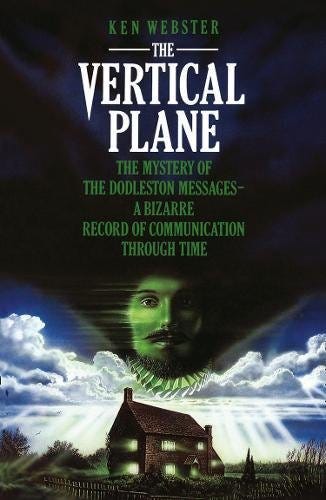Are The Dodleston Messages Fake?

Did computers in the 1980s actually talk to farmers from the 16th century? The Dodleston Messages are a semi-famous 20th century mystery in which a schoolteacher in 1984 in the peaceful English village of Dodleston, Cheshire, allegedly received messages from a man who lived in a house on the same site in 1546.
These supposed paranormal events were documented by teacher Ken Webster in his 1989 book, “The Vertical Plane.” The story has subsequently been aired on TV, YouTube and chewed over in many blogs.
It is now time to reveal the truth about the Dodleston Messages!
If somehow these really were messages from across time, what do they tell us about the universe, about time, and about life after death?
If they were fake — nothing much. But what if the Dodleston Messages were genuine?
We shall consider the facts and come to our own conclusion.
Was The Dodleston Incident a Poltergeist?
In the autumn of 1984, in the village of Dodleston in Cheshire, in the northwest of England, Ken Webster was renovating a dilapidated cottage. He had recently moved in. Webster was an economics teacher at a local school, and he lived with his girlfriend, Debbie, 19, and another friend, Nicola Bagguley, their long-term guest.
‘Ken Webster’ appears to be a pseudonym, by the way.
Not long after they moved in, weird stuff began to happen. A set of six-toed footsteps appeared to walk up the walls — a cat, maybe? But six toes?
Ken, Debbie, and their guest, Nicola, all agreed that it was a joke. They suspected each other of pulling the prank.
Ken painted over the footprints, but the following day, the prints came back.
Over days and weeks, the occupants of the Cheshire cottage experienced chalk marks appearing, sudden cold spots, a breeze strong enough to lift a newspaper into the air, a feeling of someone being there, and later on, noises like footsteps
They found tins of cat food neatly piled in a pyramid, and more weird track marks across the floor.
It seemed they had a poltergeist. But then there were more mysterious developments.
Messages on the Computer
Ken had borrowed a BBC Computer from his school. He loaned it to his guest Nicola Bagguely, who wanted to be in show business and wanted to use the word processor to write comedy sketches.
They left the computer switched on in the kitchen, and when they went back, they found messages had mysteriously appeared on the screen.
In his book, “The Vertical Plane,” Ken Webster sets out the messages received. The first was a rather ominous and obscure poem.
True are the nightmares of a person that fears.
Safe are the bodies of the silent world.
Turn pretty flower, turn towards the sun for you shall grow and sow.
But the flower reaches too high and withers in the burning light.
Get out your bricks —
Pussy Cat, Pussy Cat went to London to seek fame and fortune.
Faith must not be lost for this shall be your redeemer.
The message is signed L. W.
At first, Ken Webster said he thought this was some kind of computer prankster, and the prankster was one of the two women in the house. But as we shall see later, there may have been another prankster at play.
A few days later, another mysterious message came through, but this one was written in what appeared to be Early Modern English.
I wryte on behalf of many. Wot strange wordes thou speake, although, I muste confess that I hath also been ill schooled. Some thymes methinks alterations are somewot barful, for they breake mane a sleep in myne bed.
Thou art goodly man who hath fanciful woman who dwel in myne home, I hath no want to affrey, for onlie syth myne half wyted antic has ripped attwain myne bound hath I beene wrethed a nyte.
I hath seene manye alterations lasty charge house and thou home, tis a fitting place, with lytes whiche devil maketh, and costly thynges, that onlie myne friend, Edmund Grey can affore, or the king himselve. Twas a greate cryme to hath bribed myne house. — LW
Lukas said he was communicating through a ‘leems boyste’ or a ‘box of lights.’
Through questions and answers, the modern trio learned that L. W. stood for Lukas Wainman.
Lukas told them he lived in a house on the site of Meadow Cottage between 1543 and 1547, during the reign of King Henry VIII
He said he was a farmer and kept livestock around his house. He disclosed he was married, but his wife and son were killed in the plague in 1517.
The content of the messages told them that he had been a student at Brasenose College at Oxford University and had met the famous Dutch philosopher Erasmus three times.
As the messages went on, it became clear that Thomas could see and hear some of what was going on in Meadow Cottage. For example, he would comment on photos that Webster had left around the computer, like a picture of a Jaguar car that he talked about in a later message:
I have found your picture of the cart, but it is a crude thing for without the horse it won’t go far.
Debbie, Webster’s girlfriend, claimed she dreamed of Lukas after hearing tapping sounds, having her hair pulled, feeling physical pressure, and having a strong sense of being watched while she was alone in the cottage.
In a dream-like state, Debbie could almost be with Lukas in the past, she said, including a time where they made candles together.
Messages kept coming up on the computer for 18 months in 1985 and 1986.
Lukas Wainman could also pass messages to Ken Webster via writing on scraps of paper that appeared in 1985 at Meadow Cottage. It’s not that they survived from the earlier house. It was somehow that Lukas Wainman used some psychic ability to make impressions on paper in Webster’s time.
Peter Trinder, a teacher and friend of Webster’s, looked at the messages and declared that they were in the Early Modern English of the Tudor Period and that there were authentic dialect and old-fashioned usages that a modern person would not know.

Messages From The Past and The Future Too
The story got quite dramatic as the messages continued. Lukas Wainman stopped writing and an unnamed friend of his took up the story, sending Webster messages.
It turned out that Lukas was arrested by the local sheriff, Sir Thomas Fowleshurst because he was discovered to be communicating through this ‘light box’.
The charge was witchery.
Webster learned Lukas was later released but placed under house arrest.
Despite the charge of witchcraft hanging over his head, Lukas continued to write to Ken Webster for many months.
Lukas told Ken he was terrified what the authorities might do to him, but still continued to use the light box and to write on pieces of modern paper and send Webster drawings of things around the house.
It turned out that Lukas hadn’t been honest when he told them his name. Though he said he was called Lukas Wainman at first and signed the messages L.W., he later revealed he was actually called Thomas Hawarden.
Lukas / Thomas also wrote that he didn’t understand why Webster said he lived in 1985. He said:
Yow sayd yowr tyme be 1985 methought yow were als from 2109 lyk yowr freend whom didst bringe leems boyste prey
Then Lukas suddenly announced that the light box was brought to his house by someone called ‘One’, who hailed from the year 2109.
Webster was baffled. He wrote back asking who was this person that Lukas knew from 2109?
Still curious, Webster decided he was going to use the BBC Micro to send a simple message to the year 2109, entitled. “Calling 2109”
2109 wrote back.

The Tale of 2109
The messages from 2109 are very hard to follow. They talk in general New-Age terms about higher purposes.
This is an example of 2019’s messages
The eyes are open yet nothing do you see. The grey retarding mass is your convict. Quietly, alone he sits in the dark waiting for sentence to be passed, and demanding through the eyes of the blind of unspoken questions to answers of ethereal kind. The soul he is the traveler, chain nor bar can hold him to frail flesh. Here is the ruler of time and space. Here is your God
And another 2019 message:
Try to understand that you three have a purpose that shall in your life time change the face of history, we, 2109, must not affect your thoughts directly but give you some sort of guidance that will allow room for your own destiny. All we can say is that we are all part of the same god, whatever he is (?), is.
So now we have a story with people writing from three different dates:
- Lukas Wainman from 1543
- Ken Webster from 1985
- ‘We’ from 2109
You remember that Peter Trinder was the fellow school teacher who analysed Lukas’s old-fashioned language and declared it genuine.
But when Trinder attempted to test the messages from 2109, 2109 told him he was endangering the mission they were on.
It all sounds like an episode of Dr. Who.
Back To The Story
Remember, Lukas had been arrested for witchcraft. Ken Webster and friends now had the urgent task of saving Lukas Wainman from being burned alive.
They looked through their history books and found things that Lukas could say to explain himself and get let off the charge.
Lukas told the Sheriff what Webster told him to say, but the Sheriff was unmoved. He still wanted to try Lukas.
Bizarrely, the sheriff Sir Thomas Fowleshurst then started using the light box himself to communicate with Ken Webster. He reveals the year where he is, is actually 1546.
Messages continued from Lukas, who reveals he was expelled from Brasenose College in 1538 for refusing to denounce the Pope.
After many months of not being executed and continuing sending Webster messages, Lukas Wainman or Tomas Hawarden, was told to leave the house, and he told Webster he was going to Bristol to buy a horse to ride to Oxford to see if he can get back into Brasenose College.
Why anyone would go from Dodleston to Oxford via Bristol is beyond me. Dodleston to Oxford is 174 miles. Dodleston to Bristol is 169 miles and then a further 74 miles on horseback from Bristol to Oxford. It makes no sense to go 174 miles to buy a horse when your journey is only 169 miles.
I am guessing they had horses in Cheshire in the 1500s, and that someone would sell him one.
In fact, if you know the story of the Wizard of Alderley Edge, then you know they did and they would.
Lukas Wainman then said goodbye, saying he would write a book about his experiences, which he hoped Ken Webster will find and read in 1985.
2109 said that at some point the book will be found.
Nick Poyntz, an academic, said,
If such a book does exist and is ever found, it would be hard to argue against.
Nobody has ever found such a book.
Ken Webster did some research and found that a Thomas Hawarden was made vicar of Barrington Parva parish in Gloucestershire in 1551, and stayed there until 1554.
Thomas Hawarden would not be a unique name, though. It could easily be someone else.
There were some more odd, high-falutin’ messages from 2109 and that was the end of the Dodleston Messages
The Dodleston Paranormal Investigation
As more questions came up, Webster finally invited a group called the Society for Psychical Research (SPR) to the cottage to look into what was going on.
The SPR’s research liaison officer, John Stiles, sent down John Bucknall, who came with a colleague named Dave Welch and later with Nick-Sowerby-Johnson. They didn’t believe the story and didn’t care as much about Lukas as they did about 2109.
They came three times, but each time they left with no answers and having seen nothing happen.
Is The Language of the Dodleston Messages Authentic?
Peter Trinder was the first expert to analyse the language of the Dodleston Messages.
Trinder had a degree in English from Oxford University.
Trinder was convinced that the language was the kind of language that a person in the Tudor period would actually use. Trinder felt that Lukas’s language revealed he was from the South West of England — not, therefore, from Cheshire.
As we will see, there is a historical trace of a man who might be Lukas Wainman taking up a role as a vicar in Gloucestershire. So he might have had connections with that area.
However, In 1996, another more qualified expert, Dr. Laura Wright of Cambridge University, examined the Dodleston Messages. She said that the way Lukas put together his verbs differed from how people did so at the time.
Wright gave a simple answer when asked if it could be a fake:
“If it’s supposed to look like early modern English writing, it doesn’t even look close.”
Wright did a more damning analysis of adjectives which came before nouns. She found that both Lukas’s messages and Webster’s descriptive passages from his book used them almost as often as each other (26% and 26.6%, respectively), while a sample of other writings from the Tudor period used them significantly more at 32–35%
It was unlikely that this was genuine Tudor English.
Anomalies In The Dodleston Messages
Lukas says his wife and child were killed in the plague of 1517. I’m not sure where.
He would be at least 20, if not older at that time then. So, say he was born in 1495, or so.
He is Dean of Brasenose in 1538, aged around 43.
He is a farmer in Dodleston between 1543 and 1547, so he would be around 52 when he leaves Dodleston.
He is perhaps the same Thomas Hawarden that becomes vicar of Barrington Parva in Gloucestershire in 1551 (aged 56) and leaves there in 1554, aged 59 or so.
These dates actually sound plausible. I thought that being at University at 43 was a little old, but then he was the dean.
Harden/Hawarden/Lukas he says he got his degree at Jesus College, Oxford, which didn’t exist at the time. Harden thinks that anyone from the future would know that Jesus College didn’t exist then.
Jesus College was founded by a group of Welshmen in 1571. Therefore, when Lukas/Harden was writing in 1546, it hadn’t been built. How could Harden know it would be built some years after his death?
In an early message, Lukas says he was he was ‘ill-schooled’. That is not a description of someone who went to Oxford University, even one who was apparently dramatically kicked out, as we shall see. In fact, Lukas was said to be Dean of Brasenose College, so pretty-well schooled in fact.
Why did Thomas Hawarden claim he was Lukas Wainman?
Might it be that after doing some research, Webster discovered a Thomas Hawarden who had been at Brasenose College and was later a vicar in Gloucestershire and so changed the name, so it looked like there was historical proof of his existence. If he’d made up Lukas Wainman off-the-cuff, then he would have been unlikely to find any documentation for Lukas Wainman, but once he’d found Thomas Hawarden, then bingo!
Webster got a new job while he was still at Dodleston. This new job was much more demanding.
Webster quickly lost interest in this search for truth and said,
I became bored… I wanted to go home, to read about something else.
At about the same time that Webster got a new job, Lukas/Thomas said that he was being forced to leave his land. He was never seen or heard from again, but he promised to leave something for his friends.
Theories About The Dodleston Messages
One clear contender is that Ken Webster and Debbie were the hoaxers.
If it was someone else it is hard to see how they could have done it.
Even though there wasn’t a lot of security at the cottage, there was never any sign that it had been broken into the house.
They were in the house when messages arrived, so they can’t have been planted.
Webster used computers from a pool, so it would have been impossible to rig them all. Also, once the computers were turned off, nothing was saved, so it would have been impossible to plant information that would show up when the computers were turned back on.
This happened long before people had the internet. The computers didn’t have modems. There was no way to send the messages from another location.
So we come back to Ken and Debbie.
Remember, though Ken Webster wrote the book, Debbie played a part and claimed weird dreams where she was in touch with Lukas.
It seems they took part in the ‘Out of This World’ programme made about the Dodleston Messages and aired on TV in 1996, but apparently nothing since.
Ken and Debbie have since disappeared into the rest of their lives.
They’ve never come forward to claim the hoax. They’ve never really made any money from it either.
Lukas and 2109 have never been heard from again.

The Dodleston Messages Explained
On the surface, Webster’s story seems to be a supernatural detective story that tries to find the truth.
Who was/is Tomas Harden? Did he even live? Were his messages real, or were they made up by someone who knew the sources well?
In the book, during the first few days of the haunting, if that’s what it was, Webster’s character spends a lot of time learning about early modern Chester and the surrounding area.
While doing his research, Ken Webster found evidence that Sir Thomas Fowleshurst was the Sheriff of the Dodleston area in the mid-1500s.
This seemed to confirm Lukas’s story.
But did he find out about Thomas Fowleshurst first before Lukas mentioned him, and only claim that he discovered Fowleshust after Lukas mentioned him?
Later, Webster was thrilled when Robin Peedell, an assistant librarian at Brasenose in the 1980s, found Harden’s name in the University’s records, which seems to confirm Harden’s story that he was there.
I’m not sure if the claim that he was Dean of the College was substantiated, though.
Webster moved from the local school to a job in Manchester, and the story died. No one at that house, as far as I am aware, has reported any paranormal activity in the years since.
Then, we know that historical facts given by Lukas turn out not to be true.
Add this that a reputable expert is very confident that the language of the messages is not authentic Tudor English and most resembles Webster’s own language.
The plot of the Dodleston Messages with all their twists and turns sound like the plot of a 1970s British sci-fi TV series like Dr Who or Timeslip, or Children of the Stones.
I think the whole thing started out with Ken Webster playing pranks on his houseguest Nicola and then getting carried away with the fun of it.
He probably never expected it to go so far and then wondered if there was an opportunity for a best-selling book.
After all, novels like The Exorcist and The Amityville Horror had made millions, and they were supposed to be based on a true story
I think that Webster wrote his science-fiction book “The Vertical Plane,” and saying it was based on a true story was his way to up the sales.
Conclusion
It’s my opinion that the Dodleston Messages were almost certainly fabricated by Ken Webster and his girlfriend, Debbie. They are false, fake, counterfeit.
As I work through all these great paranormal mysteries, they all seem to be based on exaggeration if not down-right lies.
And that’s a pity, because I want to believe.
Stay At The Haunted Royal George, Knutsford
Read More: Can You Make a Ghost?
Links For Further Reading
- Nick Poyntz’s blog post
- https://mercuriuspoliticus.wordpress.com/2010/11/01/ghost-in-the-machine/
- Peter Trinder interviewed about the Dodleston Messages
- https://www.youtube.com/watch?v=qitzTjdqYVo
- There is a private Facebook Group about the Dodleston Messages. It is still pretty active it seems.
- https://www.facebook.com/groups/351602963651414
Global window cache. Return value stars. Config version const.


